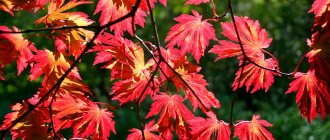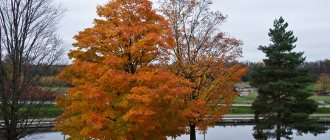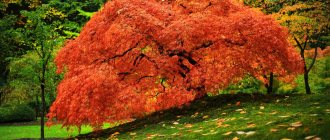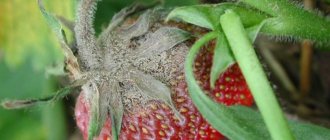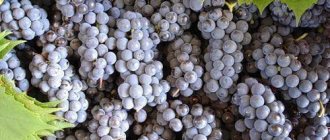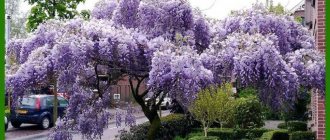Types and varieties of red maple, appearance
Red maple is a deciduous tree from the Maple (Sapindaceae) family. This is a large tree that can reach a height of 9 to 28 m, with red leaves located oppositely. The leaves can be from 5 to 10 cm in length, five-lobed and pointed at the ends, have a dark green color, but turn red in winter.
The crown of the tree has a spherical shape, so it does not need pruning. Maple bark appears smooth and gray-brown in color, but becomes darker and cracks with age. It blooms differently, depending on the sex of the tree: female flowers are bright red, collected in a raceme, while male flowers have yellow stamens.
Maple varieties:
- October Glory is a pyramidal maple that can grow up to 18 m in height. In summer the leaves are green, and in autumn they are burgundy.
- Red Sunset is the best variety of red maple; its crown shape resembles a wide pyramid. In autumn the leaves turn bright red.
- The Canadian red maple is a red-leaved maple that can reach a height of up to 40 m. It is grown as an ornamental tree.
- Scanlon is a maple with a regular pyramidal crown up to 12 m high. In summer the leaves are green and turn purple in autumn.
- Brandywine - grows quite quickly, the crown has a regular oval shape, in the fall the leaves turn purple-red.
- Magnificent Magenta is a beautiful oval-shaped maple with colorful leaves in the fall: red, burgundy or purple.
- Summer Red is a small tree up to 10 m in height. The crown has a regular oval or round shape, and the colors of the leaves vary from orange to crimson with a purple tint.
- Sekka is a dwarf species of red maple, great for summer cottages. Does not grow above 8 m in height; in autumn the leaves turn deep red.
- Sun Valley is a low-growing maple with striking bright red leaf color. Ideally decorates garden areas.
Diseases and pests
Maple, whose red leaves are pleasing to the eye, may suffer from powdery mildew and coral spotting. Shoots damaged by plant parasites should be removed, the cut areas should be covered with garden varnish and the tools should be disinfected. Before the buds open, you can treat with copper sulfate and pollinate with sulfur. Trees and shrubs are subject to attacks by phytophages: maple whitefly, mealybug, leaf weevil. Spraying is carried out at the stage of feeding larvae with the preparation "Actellik", in the fall dry leaves are collected and destroyed.
Where and how does it grow
Red maple varieties are usually unpretentious to where they are planted, but there are still some rules to follow. The tree is not recommended to be planted in fairly open and windy areas; a well-lit, spacious area is suitable for it. As a soil, you need to choose light soil with good air permeability. The tree should be planted in the spring - from early to mid-April, so it will better take root and adapt before winter.
Culture propagation
Red maple, like a large number of other plants, should be propagated by cuttings or seeds .
When choosing a method of propagating a crop using cuttings, they should be harvested and cut in the fall, and buried in a special hole before spring. In spring, overwintered cuttings should be transplanted into pots with light soil mixed with sand.
If you grow red maple from seeds, then you should collect “helicopters” with seeds and keep them in the winter at a special temperature of 0--3 degrees Celsius. In the spring, before planting the seeds, they should be soaked, and when a sprout begins to hatch from them, sow them in a hole with a total depth of up to five centimeters. In the summer, sprouted seeds should be given good shade and moderate watering. At the moment when the seedlings grow to the mark of fifty to eighty centimeters, they should be transplanted to a permanent place of cultivation.
Benefit
Red maple has enormous natural benefits, as animals such as white-tailed deer, elk, elk, and white hare feed on its twigs and leaves. Owls, crested woodpeckers and golden avoceous woodpeckers nest on the branches of these trees. In addition, maple has decorative benefits and is also widely used for landscaping gardens and parks.
Landing specifics
Even experienced gardeners do not always risk purchasing capricious representatives of Asian flora, believing that such plants are unsuitable for growing in harsh climates
Nevertheless, it is quite possible to grow a red maple in your dacha - it is only important to take into account some nuances
Firstly, to plant a tree, choose a place where the top fertile layer of the earth will be sufficiently moist
It is important that the soil does not contain a large amount of stagnant moisture, as this has a detrimental effect on the seedlings
Secondly, you should take care of protection from the wind. It cannot be said that drafts are terrible for maple, but in a quiet and cozy place the growth rate of a woody plant will increase significantly.
There are no special requirements for lighting. It goes without saying that a completely dark place is an unsuitable environment for the full development of trees and shrubs. In addition, we must not forget that the natural processes of photosynthesis cannot occur without light. In addition to this, the sun's rays reflecting off the variegated maple leaves create a stunning picture.
As already mentioned, the Asian woody plant prefers moist soil, but does not like excessive accumulation of water. In this regard, experienced gardeners strongly recommend making high-quality drainage for the root system of the plant.
The technological process of planting a red maple tree consists of several sequential steps:
- Prepare a hole that should be at least twice as wide and deep as the root ball.
- For a seedling taken out of a container, first carefully loosen the soil between the root shoots, and then straighten the roots.
- The soil soaked in fertilizers is poured into the hole. The maple should be located in the hole at the same depth as it was in the container.
- Having filled the hole with soil and compost, carefully compact it from above.
- A small mound of soil is formed around the planting site to prevent water from spreading when watering.
How to grow, care
Red maple (you will see the photo below) requires preparation of a planting hole. You should carefully dig up the area for planting the tree, then dig a hole approximately 50x70 cm in size. At the bottom of the hole, do not forget to make a drainage layer, especially if the soil is clayey and heavy. Then you need to pour a large amount of water into the hole and wait until it is absorbed.
It is recommended to prepare a nutritious mixture of turf soil, peat, humus and mineral fertilizer. Then you need to lower the seedling into the prepared hole and fill it with soil. Please note that red maple does not like deep planting.
While the tree is young, it should be shaded from direct sunlight until it gets stronger. It is necessary to periodically moisten the soil, watering the tree as needed.
Only young trees and those planted for decorative purposes require care to maintain their beautiful appearance. Mature trees, as a rule, grow well and for a long time.
Recommendations for caring for maples
- Feeding - its need depends on the age of the tree. It is recommended to feed the maple tree during the first four years after planting. For feeding, you can use superphosphates, potassium salt, and urea.
- Watering - one maple requires 15-20 liters of water, it is best if it is rainy and slightly warm. Watering should be done at the root. The frequency of watering depends on the soil, the climate in your area and other factors.
- Pruning must be done in the spring for sanitary purposes. Trim dry shoots and damaged branches. You can trim the shoots of those maples that have a tendency to thicken the crown.
- Preparing for winter - maples usually tolerate cold well, but you can protect the tree with the following techniques: cover the trunk with spruce branches or insulate it with burlap.
Handsome maple tree in landscape design: 60 photos of successful application ideas
Maple leaves in autumn are an invariable attribute of inspiration for artists and landscape designers. One can talk for a long time and with rapture about this beautiful representative of the flora, which is often used in landscaping gardens, parks and alleys, but it is much more useful to familiarize yourself with the successful ideas for using all types of maple in the photo.
Maple has long been used in landscape design due to the fact that this tall, slender plant is incredibly beautiful and undemanding to care. Today, there are as many as 150 varieties of shrub and tree maples!
Plant sizes vary: from low ornamental shrubs to huge, powerful trees with a dense crown. The foliage also deserves special attention, because some maples can change their color three times during the season. The shape of the leaves is very diverse, but they have one common feature - they are pointed, however, this is not surprising, since maple, or acer, is translated from Latin as “sharp.”
In landscape design, tree maple is often used as a tapeworm, which invariably attracts attention. Red maple, which has a luxurious spreading crown, is especially good when planted alone. The foliage is green in the summer and then changes to fiery colors as fall approaches. This type is frost and moisture resistant.
Norway maple Globosum, which has a rounded crown on a thin long trunk, has proven itself well in landscaping. A tapeworm with such a tree will look original in your garden.
The maple alleys are simply breathtaking!
River maple, also called Ginnala maple, loves sun and moisture, so it is good to plant it near natural or artificial reservoirs. Often this variety of plant is used in Japanese-style gardens, where there is a lot of vegetation and water. This species is also frost-resistant, which is important for our climate zone.
Low varieties of maples look good on borders and ridges in the company of conifers and other decorative deciduous plants.
Recent Entries
5 working ways to use tar in the garden 7 indoor plants that help you get married even in adulthood Indoor plants that can bloom in trouble
Living maple hedges are created from low trees or from shrub varieties that tolerate pruning well.
Field maple hedge
The greenbark maple, which “adores” dust, smoke and gas, will feel great in city park areas and squares. This species is named so because of the special gray-white-green color of the bark. In the spring, during the flowering period, the maple attracts insects, as it is an excellent honey plant, and in the fall, the wide leaves turn into bright yellow flashes, creating an accent in gardens.
It must be said that many varieties of maples are quite stress-resistant and have adapted well to city life.
Green maple
Japanese maple in Doho park
In eco-gardens, maple plantings are simply irreplaceable, because such bright trees and shrubs are doomed to attract everyone's attention.
Any group plantings in mixborders with the participation of maples will look elegant and attractive. Multi-colored plants with carved leaves go well with barberry, snowberry, lilac, dogwood and mahonia.
Maple and barberry
In large flowerpots, dwarf Japanese maple looks very beautiful! In the art of bonsai, breeders specially created colored types of maples: blue, red and even purple.
Still, maples are amazing plants with stunning foliage! There are so many colors!
This is not a complete list of shades:
- salmon pink (Eskimo Sunset variety);
- deep burgundy (Faassen's Black);
- fiery red (Fairview);
- lemon yellow (Auratum);
- ocher (Scanlon);
- green with white border (Drummondi);
- light green (Princeton Gold);
- red-brown (Crimson Sentry);
- bronze (Summershade);
- green-pink (Flamingo).
Palm maple
Maple Tsuma Gaki
Norway maple Royal Red
Acer maple "Flamingo"
Maple "Crimson King"
Norway maple Drummondii
Undoubtedly, the maple on your site will attract attention with its beauty, but you still need to take into account one of its features: this handsome guy is very prolific and grows quickly. Can you cope with such a lively creature?
- Author: Ilona Lukina
Rate this article:
- 5
- 4
- 3
- 2
- 1
(17 votes, average: 4.5 out of 5)
Share with your friends!
Description of the species
Red maple, otherwise known as red maple, is one of more than 150 varieties of crops that belongs to the maple family. The plant originates from Southeast Asia; the plant has gained great popularity in Japan, where it grows not only in open soil, but is also successfully used in the cultivation of potted plants, and is also grown in special tubs for decorating verandas, terraces and balconies.
The common name red maple refers to several varieties of maple trees with specially colored leaves. The most popular of them are:
- Japanese red maple;
- Shirasavi maple;
- palm-shaped (a tree with palm-type leaves), or fan-shaped.
The tree owes its unusual beauty and decorative leaf colors to the special biochemical composition that is characteristic of these trees. In addition to chlorophyll, which provides the green color of the plant, maple also has a large amount of carotenoids, which in most cases give red, yellow and orange colors to the leaves. The cell sap of plants contains a large amount of anthocyanins, which color the foliage purple and carmine, which harmonizes beautifully with the gray color of tree bark.
The crown of red-leaved maples, as is often the case, is round or oval in shape; in some cases, mushroom-shaped trees can be found. The cut finger-shaped leaves look more like lace gloves. In this culture, absolutely everything is considered decorative - foliage, which changes its color and saturation from spring to autumn, as well as silver-gray bark and thin branches with leaves that have fallen in winter.
The ornamental plant is considered very hardy, but does not like direct sunlight, drafts and low temperatures: below -15 degrees Celsius. The best place to grow red maple will be a wind-protected area in the garden with a mosaic type of lighting.
How to care for mature trees
When the plant has grown and become strong enough, caring for it does not require much effort. Red maple after planting and up to four years of age requires care in terms of fertilizers. After this, minerals should be added to the soil no more than once every two years. Many ornamental plants are adapted to grow in wild conditions, for example, in the forest, where no one cares for them. And at the same time, trees grow normally for 100-150 years. But an ornamental tree requires care in order for it to remain beautiful and bright.
To do this, cut off some branches, especially dried ones. You also need to cut down all the branches that interfere with growth. Experts recommend not cutting off the shoots; the maple plant should be branched. The tree can be given a beautiful rounded crown. The ideal season for tree pruning is August-December. If you do not comply with these time limits, the plant may begin to “cry”.
Read also: Sunflower cake and sunflower meal, what are the differences between the products
Red maple in the garden
Red maple is a hardy plant that is vulnerable to excessive light, as well as to drafts and increased soil moisture.
Plants and shrubs affected by poor conditions begin to shed their foliage very early. Branches, as well as the root system, begin to quickly become damaged under the influence of low temperatures if it is below -15 degrees Celsius in winter.
Maples do not like to grow in open, south-facing areas with high levels of light. The best place for their growth will be a place protected from drafts, which will have mosaic lighting. All crops are well suited for an Asian-style garden plot, as well as for general landscaping of the front garden and patio.
